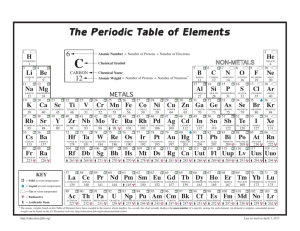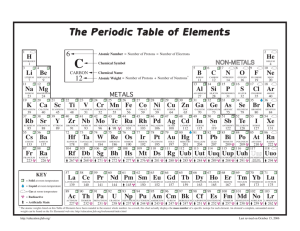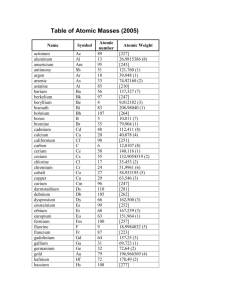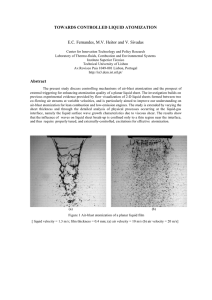Atomic Absorption and Atomic Fluorescence Spectroscopy
advertisement
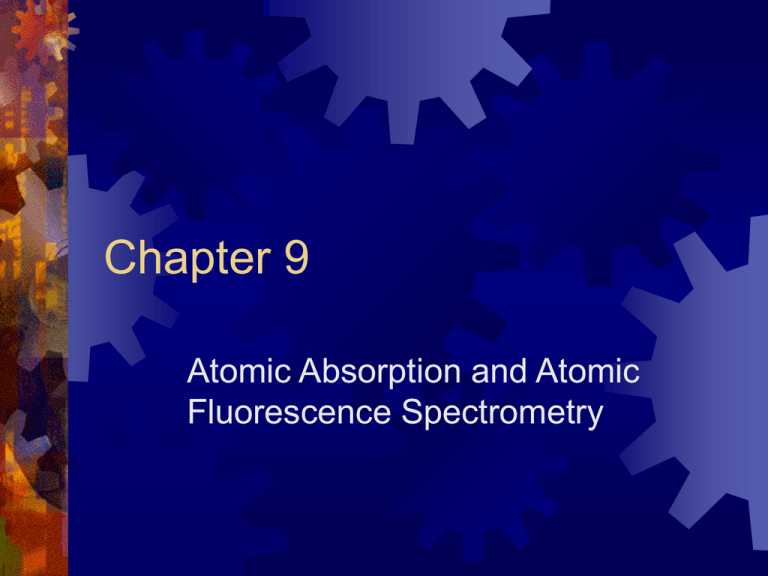
Chapter 9 Atomic Absorption and Atomic Fluorescence Spectrometry Atomic Spectroscopy Atomization is by far the most critical step in atomic spectroscopy. In AAS and AFS there are two factors involved. The intensity of light source. The probability of transition. Flame Atomization Flame Structure Flame Atomizer Flame Atomizer Electrothermal Atomizers Graphite furnace atomic absorption spectrometry (GFAAS) is also known by various other acronyms, including electrothermal atomic absorption spectrometry (ETAAS). An ideal graphite furnace should fulfill the following requirements: A constant temperature in time and space during the interval in which free atoms are produced Quantitative atom formation regardless of the sample composition Separate control of the volatilization and atomization processes High sensitivity and good detection limits A minimum of spectral interferences Specialized Atomization Techniques Glow Discharge Atomization Hydride Atomization Cold-Vapor Atomization Flame Atomic Absorption Spectroscopy Radiation Sources Doppler Broadening Pressure Broadening Electrodeless Discharge Lamps Source Modulation Hollow Cathode Lamps: Spectrophotometers In general, the instrument must contain: Narrow bandwidth to isolate the line chosen for measurement Sufficient glass filter Interchangeable interference filters Good-quality ultraviolet/visible monochromators Photomultiplier tubes Spectrophotometers Single-Beam Double-Beam Spectral Interferences The Two-Line Correction Method The Continuum-Source Correction Method Background Correction Based on the Zeeman Effect Background Correction Based on the Source Self-Reversal Chemical Interference The equilibria of principle interest include: Formation of Compounds of Low Volatility Dissociation Reactions Ionization Calibration Curves Should follow Beer’s Law Standard Addition Method Instrumentation Sources: Hollow Cathode Lamp- only observed the fluorescent signal during pulses Electrodeless Discharge Lampproduced intensities that exceed those of hollow cathode lamps Lasers- ideal source with high intensities and narrow bandwidths Instrumentation Dispersive Instruments- They are made up of a modulated source, an atomizer, a monochromator or an interference filter system, a detector, and a signal processor and readout. Nondispersive Instruments- They ideally are made up of a source, an atomizer, and a detector. Advantages: Simplicity and low-cost instrumentation Ready adaptability to multi-element analysis High-energy throughput and thus high sensitivity Simultaneous collection of energy from multiple lines, enhancing sensitivity References www.anachemumu.se.htm www.aurora-instr.com/right.htm www.anachem.umu.se/jumpstation.htm www.anachem.umu.se/cgi/jumpstation.exe?AtomicSpectroscopy www.anachem.umu.se/cgi/jumpstation.exe?OpticalMolecularSpectrosc opy www.minyos.its.rmit.edu.au/~rcmfa/mstheory.html http://science.widener.edu/sub/ftir/intro_it.html http://www.s-a-s.org/ http://www.chemsw.com http://www.scimedia.com/chem-ed/spec/atomic/aa.htm http://nercdg.org http://www.analyticon.com www.lcgmag.com/ www.lcms.com/ References www.dq.fct.unl.pt/QOF/Chroma.html www-ssg.chem.utas.edu.au/ www.yahoo.com/science/chemistry/chromatography/ www.onlinegc.com http://www.scimedia.com/chem-ed/analytic/ac-meth.htm http://www.scimedia.com/chem-ed/spec/atomic/aa.htm http://www.scimedia.com/chem-ed/spec/atomic/afs.htm http://www.cee.vt.edu/program_areas/environmental/teach/smprimer/aa /aa.html#Features http://www.anachem.umu.se/aas/gfaas.htm http://www.agsci.ubc.ca/fnh/courses/food302/atomic/aatomic03.htm#el ectro http://www.scpscience.com/products/AA/hollowlamps.asp http://las.perkinelmer.com/catalog/Product.aspx?ProductId=N3050691 http://elchem.kaist.ac.kr/vt/chem-ed/spec/atomic/aa.htm


